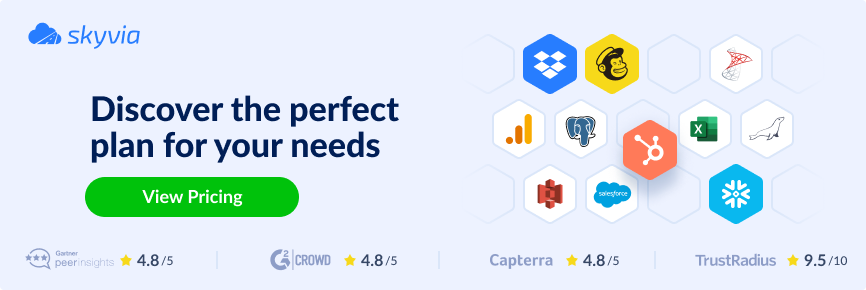Let’s dive into the world of data lineage, a lifesaver for businesses that need to manage dataflows effectively.
In this guide, we’ll look at the Top Data Lineage Tools for Businesses in 2025, exploring how they can help organizations stay on top, improve transparency, and ensure compliance.
Table of Content
- What Are Data Lineage Tools?
- Key Benefits of Using Data Lineage Tools for Businesses
- Types of Data Lineage Tools
- Top Data Lineage Tools in 2025
- Best Practices for Choosing a Data Lineage Tool
- Enhancing Data Lineage with Skyvia
- Conclusion
What Are Data Lineage Tools?
Data lineage tools are specialized software that automatically track the movement and transformation of data across different systems, databases, and applications. They provide a visual map that helps teams see where data originates, where it travels, and how it’s altered along the way. These tools:
- Optimize workflows.
- Help businesses dealing with complex ecosystems.
- Fit companies that need to improve transparency.
- Resolve issues quickly.
Why is Data Lineage Essential?
Imagine trying to figure out why your business reports suddenly show odd results. It’s like trying to solve a mystery without any clues, without knowing where the data came from, how it was processed, and whether there were any transformations along the way. That’s where data lineage tools come in. They help track the entire data lifecycle, ensuring you know exactly what happens at every step.
Overall data lineage is essential for:
- Data accuracy. Understanding what parts have changed over time helps maintain consistency and avoid errors.
- Compliance and auditing. With regulations like GDPR and CCPA, companies must prove where information comes from and how it’s handled.
- Data governance. Effective data management means knowing who is responsible for what and ensuring that the data is being used properly.
How Do Data Lineage Tools Help?
- According to a survey by IBM, 75% of businesses struggle to maintain data quality across their systems, and many of these challenges are due to a lack of visibility into workflows. The lineage solutions solve this by clearly showing how information moves and transforms, ensuring higher accuracy and better decision-making.
- A report from Gartner shows that companies using data lineage tools see a 30% reduction in time spent on root cause analysis when issues arise. Instead of spending hours figuring out where the problem lies, teams can quickly pinpoint where errors occurred and resolve them faster.
Key Benefits of Using Data Lineage Tools for Businesses
In a world where businesses rely heavily on data for decision-making, having visibility of its movement and transformation is crucial. Data lineage tools are game-changers for companies looking to enhance data governance, ensure regulatory compliance, and improve data quality. They provide the transparency needed to track dataflows across systems, fix problems before they escalate, and ensure that businesses meet regulatory standards.
| Key Benefit | Description | Impact Area |
|---|---|---|
| Tracking data ownership | Identifies data owners, ensuring quality management. | Governance |
| Improving data transparency | Visualizes data flow, maintaining consistency. | Governance |
| Boosting collaboration | Facilitates teamwork on data projects. | Governance |
| Root cause analysis | Pinpoints data issues, fixing errors at the source. | Quality |
| Detecting inconsistencies | Highlights unexpected data changes for standardization. | Quality |
| Data tracking for audits | Documents data movement for regulatory audits. | Compliance |
Enhancing Data Governance
- Tracking ownership. Companies can identify who owns specific files, making it clear who is responsible for managing them.
- Improving transparency. By visualizing how data flows through the ecosystem, everyone involved can see where data comes from, how it’s transformed, and how it’s used, helping to maintain consistency across the organization.
- Boosting collaboration. Collaborating on data-related projects becomes more manageable for teams across departments. With a clear understanding of how information is shared and processed, users may enforce data governance policies more effectively.
Improving Data Quality
- Root cause analysis. When a quality issue arises, it’s easy to pinpoint where the problem occurred. Users can trace the files to its origin and fix errors at the source, leading to more reliable insights.
- Detecting inconsistencies. If data is being transformed or manipulated unexpectedly, lineage tools can highlight those changes, allowing teams to standardize processes and ensure system consistency.
- Preventing future issues. By regularly tracking the flow and transformations, such tools can help identify patterns that may lead to data quality problems, allowing businesses to address them before they affect operations.
Ensuring Regulatory Compliance
- Data tracking for audits. Clear documentation of data movements, which is vital for audits and demonstrating compliance. It shows regulators where personal information comes from, where it’s stored, and who has access to it.
- Managing consent and access. These tools allow businesses to track where sensitive or personal data is being used, helping to ensure that data is handled according to consent rules and that no unauthorized access occurs.
Types of Data Lineage Tools
As usual, there’s no one-size-fits-all solution. Businesses have different needs, and luckily, there are two types of tools to suit various requirements:
- Embedded.
- Standalone.
Standalone tools focus solely on data lineage tracking and are independent of other platforms. They provide features like:
- Visualization of dataflow across multiple platforms.
- Automated tracking of data movement and transformations.
They’re ideal for businesses needing detailed, cross-platform visibility of their data’s journey and can be:
- Open-source, like OpenLineage or Spline, offers users the flexibility to customize and build their solutions.
- Commercial, like MANTA, Collibra, or Octopai, with full support and advanced features and often used by enterprises.
Embedded tools are part of a larger data management platform, such as a database, ETL tool, or DWH. These services provide lineage functionality as an additional feature but are not dedicated solely to lineage tracking and include:
- ETL tools, like Informatica PowerCenter and Talend, offer built-in lineage tracking as part of their integration capabilities.
- Databases, like Snowflake or SQL Server, offer lineage features to track transformations within the database.
Embedded tools are typically more convenient if you already use the platform for other purposes, but they may offer limited functionality compared to standalone ones. These can also be:
- Open-source, like Apache Atlas in the Hadoop ecosystem.
- Commercial, like Informatica or Talend, with lineage as part of their premium offerings.
Comparison: Open-Source vs. Commercial Lineage Tools
| Feature | Open-Source Lineage Tools | Commercial Lineage Tools |
|---|---|---|
| Cost | Free to use, which is great for small businesses or startups. | Paid, often with high licensing fees, but worth it for enterprise-level support and functionality. |
| Customization | Highly customizable, which is perfect if you have the technical team to modify it to your specific needs. | Limited customization, but comes with pre-built, easy-to-use features and professional support. |
| Ease of Setup | Can be tricky to set up, usually requiring technical expertise and ongoing maintenance. | Easy to set up with full support, and no need for technical know-how. |
| Support | Community-based support (which can be slower or inconsistent). | Professional support and regular updates are provided, ensuring quick resolution of issues. |
| Scalability | Can be scalable if configured correctly but might require significant effort. | Designed to scale easily, especially for large enterprises with massive amounts of data. |
| Advanced Features | Often lacks advanced features such as real-time tracking, automated reports, and AI-driven analytics. | Includes advanced features such as automated lineage tracking, real-time updates, and enterprise-level analytics. |
| Integration with Other Tools | Integrating with other systems can be difficult and require custom coding. | Typically integrates easily with existing data management systems, databases, and cloud platforms. |
Top Data Lineage Tools in 2025
OpenMetadata
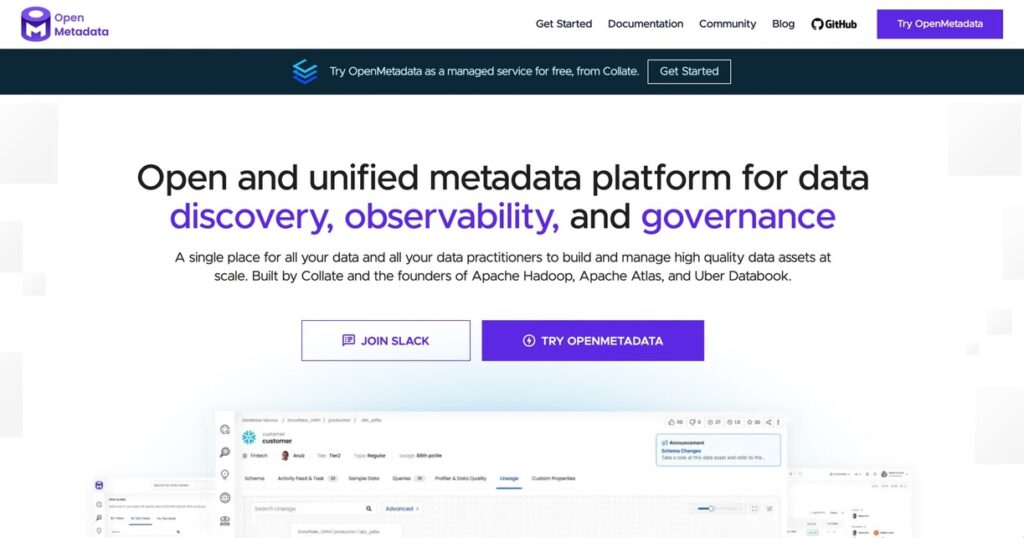
OpenMetadata is an open-source tool that simplifies metadata management and data governance across an organization. It offers an intuitive interface for managing data lineage and integrates easily with popular data sources like Apache Kafka, Snowflake, and MySQL. Its extensibility makes it suitable for businesses with diverse data architectures, enabling effortlessly mapping and visualization of data lineage.
Benefits
- Enhanced Data Governance. OpenMetadata’s flexible framework helps businesses organize and control their data, improving team governance efforts. The tool promotes transparency and enables stakeholders to track how data is used and transformed.
- Ease of Use. Its user-friendly interface makes it accessible to a range of users, even those without technical expertise, ensuring broader adoption across teams.
- Integration-Friendly. OpenMetadata’s wide range of connectors makes it easy to integrate into existing infrastructures, ensuring seamless data flow and lineage tracking across multiple platforms.
Drawbacks
- Limited Advanced Features. OpenMetadata offers great features for basic data lineage. However, it might lack the advanced automation and real-time tracking features that larger enterprises might need.
OpenLineage + Marquez
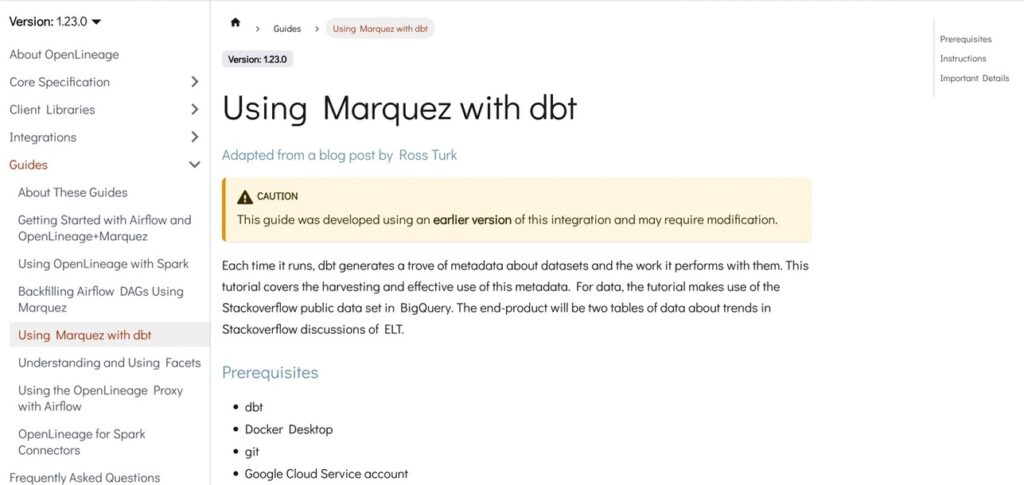
The combination of OpenLineage and Marquez provides an open-source solution for capturing and visualizing data lineage. OpenLineage defines a standard for tracking data lineage, while Marquez acts as a metadata service that collects, stores, and visualizes data flow in real-time. They enable organizations to track data movement across complex data ecosystems with precision and accuracy.
Benefits
- Standardized Lineage Tracking. OpenLineage sets a consistent standard for capturing metadata, ensuring traceability across various data systems, and reducing discrepancies in data flow.
- Real-Time Visibility. When paired with Marquez, users gain real-time insights into data pipelines, making it easier to spot issues or bottlenecks and address them quickly.
- Customizable. OpenLineage and Marquez provide flexibility, allowing businesses to tailor lineage tracking to fit their specific workflows and architectures.
Drawbacks
- Complex Integration. Integrating OpenLineage with Marquez and configuring the ecosystem can be challenging, requiring strong technical expertise to leverage the toolset fully.
- Steep Learning Curve. Due to the technical nature of the tool, teams without experienced data engineers may find it difficult to deploy and manage effectively.
Apache Atlas
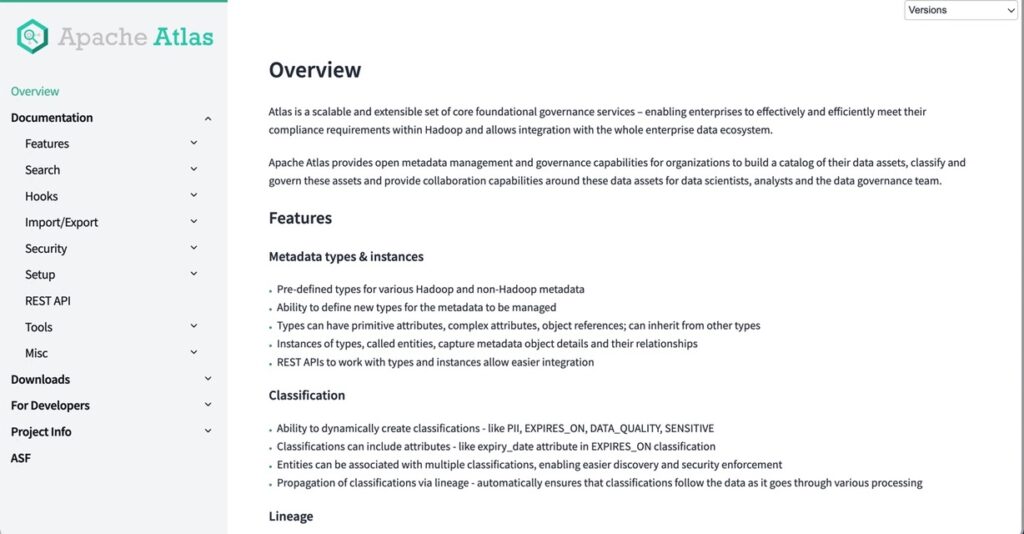
Apache Atlas is a powerful, open-source tool for metadata management and data governance within Hadoop and other distributed data environments. Its robust framework allows businesses to define, track, and query lineage information across various systems. Apache Atlas excels in helping organizations map out complex data flows cohesively while integrating well with platforms like Hive, HBase, and Spark.
Benefits
- Strong Metadata Management. Apache Atlas handles complex metadata and lineage management across large-scale, distributed environments. It’s perfect for organizations with diverse data architectures.
- Flexible Integration. Seamless integration with the Hadoop ecosystem makes Apache Atlas a top choice for companies already using Hadoop-based tools, enabling complete visibility into data flows across systems.
- Advanced Governance. Its detailed governance features allow businesses to control data usage, access, and compliance, providing a comprehensive view of how data is handled across the organization.
Drawbacks
- Learning Curve Apache Atlas can be difficult to implement and master, especially for organizations unfamiliar with Hadoop and its tools.
- Scalability Issues. Apache Atlas may not be as effective in tracking lineage across other systems or platforms for enterprises that need to scale beyond Hadoop environments.
Egeria
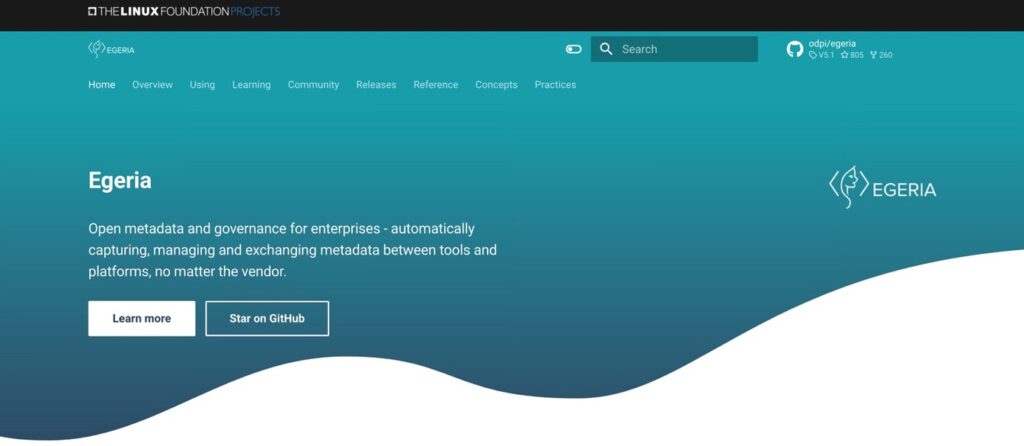
Egeria is also an open-source solution designed for enterprise-level data governance and lineage tracking. Built for collaboration, Egeria enables organizations to share and manage metadata across various platforms, ensuring that all teams are aligned on data usage and governance standards. Its governance framework allows multiple teams to collaborate on data lineage projects, promoting transparency and compliance.
Benefits
- Collaboration. Its open governance approach ensures all stakeholders can see how data is used and transformed.
- Open Governance. The platform’s open-source framework allows for extensive customization, making it suitable for businesses with complex data governance needs.
- Enterprise-Level Scalability. It handles large-scale environments, allowing enterprises to track and manage data across multiple platforms.
Drawbacks
- Complex Deployment. Setting up and deploying the platform can be complicated, particularly for organizations without dedicated data engineering resources.
- Maintenance Requirements. Ongoing maintenance and customization require technical expertise, and smaller teams may find it resource-intensive.
Spline
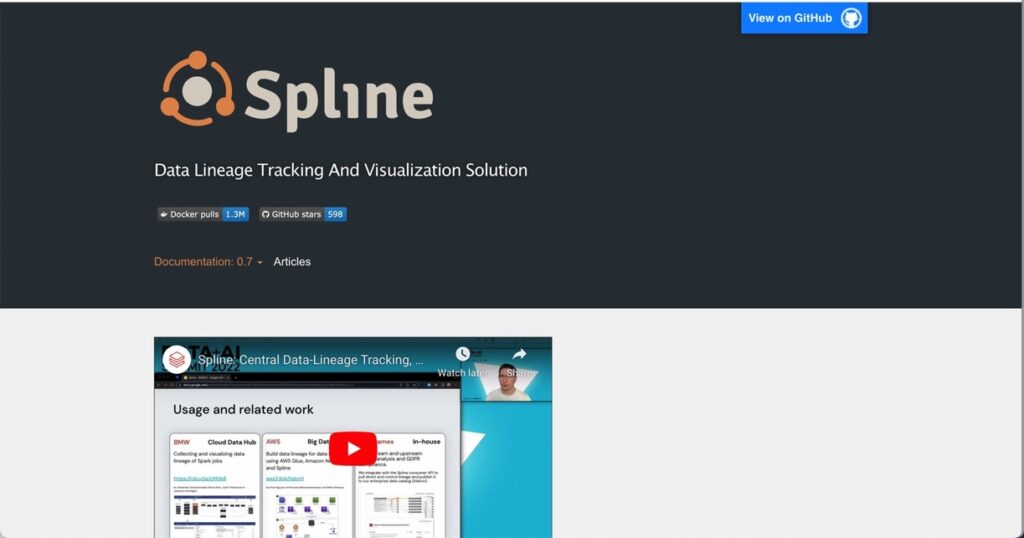
Spline is a simple yet effective open-source tool for tracking and visualizing real-time data lineage in data processing frameworks like Apache Spark. It helps users capture and display how data is transformed through various stages, offering clear visibility into its lifecycle. Spline is lightweight and focuses on providing a streamlined solution for visualizing data flows without unnecessary complexity.
Benefits
- Real-Time Lineage Tracking. Spline excels at real-time data lineage tracking, giving businesses immediate insights into how pipelines transform data.
- Simplicity. Its lightweight design and easy setup make Spline an excellent choice for teams that need quick and simple lineage tracking without the overhead of more complex tools.
- Integration with Spark. Spline integrates seamlessly with Apache Spark, making it an ideal choice for organizations already using Spark for data processing.
Drawbacks
- Limited Customization. While Spline is great for basic lineage tracking, it lacks the advanced customization options some enterprises might need.
- Scalability: Spline works well for small to medium-sized data environments but may not scale as effectively for larger organizations with more complex data ecosystems.
Best Practices for Choosing a Data Lineage Tool
Choosing the right data lineage tool can feel overwhelming, especially with so many options. However, there are a few best practices to help users search for the perfect tool for their business needs.
1. Assess Your Current Data Infrastructure
Before diving into any tool, take a step back and assess your current setup. Think of it like taking a look on everything before organizing a big closet — you need to know what you have to make the right decisions.
- Map Out Your Systems. What data platforms, databases, and tools are you already using? Are you working with cloud-based systems, on-premise databases, or a hybrid? Understanding your infrastructure is critical because your chosen tool must integrate smoothly with these systems.
- Determine Your Data Complexity. How complex is your data environment? If you’re dealing with multi-platform, cross-functional data systems, you’ll need a tool with advanced integration and tracking capabilities. For simpler setups, a more straightforward tool might do the job just fine.
- Consider Existing Gaps. Where are the pain points in your dataflows? If you’re struggling with siloed data or poor visibility into how it moves across systems, you’ll need a tool that gives end-to-end insights.
2. Choose a Tool That Scales
Data needs rarely stay the same. As your business evolves, so does your requirements. That’s why it’s crucial to pick a scalable tool for your stack. You don’t want to invest in a service only to outgrow it a year later.
- Think Long-Term. How do you expect your data needs to change over the next few years? If your business plans to scale, the service should be able to handle larger volumes of data, more complex transformations, and additional integrations with new systems.
- Future-Proof Your Choice. Look for a tool that meets your current requirements and offers advanced features you might need later, like real-time lineage tracking, AI-powered insights, or more robust governance capabilities. You want a platform that’s ready to grow alongside your data strategy.
- Flexible Integrations. Ensure that your chosen service can easily integrate with new platforms or data sources. A scalable tool should be flexible enough to handle whatever changes come its way, whether you’re adding new cloud platforms, databases, etc.
3. Go for User-Friendly Tools and Training
The best tool is the one your team will actually use. No matter how powerful the it is, people won’t take full advantage of it if it’s too complex. This is why ease of use and adequate training are so important.
- User-Friendly Interface. Look for services with intuitive dashboards and visualization features. If your team can easily track, monitor, and visualize data lineage without digging through endless configurations, they’re more likely to adopt it into their daily workflows.
- Training and Support. Even the most user-friendly platform will require some training. Ensure the vendor provides good documentation, tutorials, and customer support to help your team get up to speed. If the tool offers hands-on training sessions or has an active user community, that’s a huge plus.
- Involve Your Teams Early. Don’t wait until the service is fully implemented to get your team involved. Engage them early in the decision-making process. Let them test the platforms during free trials and ask for their feedback.
4. Consider How Data Lineage Tools Gather Data
Typically, they connect to databases, data warehouses, data lakes, ETL processes, and business intelligence platforms to track how it flows and transforms throughout its lifecycle. Here’s what services usually do:
- Direct Database Connection. To extract metadata, connect directly to databases and DWHs (e.g., Amazon Redshift, Snowflake, MySQL). They capture details like table structures, relationships, stored procedures, and dataflows between tables, which helps map out dependencies.
- Integration with ETL Tools. Services can integrate with ETL platforms like Skyvia, Informatica, Talend, Apache NiFi, or AWS Glue to understand how data is transformed. They monitor ETL jobs, mapping out the transformations and dataflow logic, which provides visibility into each step from data ingestion to the final load.
- Logs and Metadata Extraction. Data lineage solutions often ingest logs and metadata from data processing platforms, BI tools (Tableau and Looker), or data lakes (AWS S3). By analyzing this metadata, lineage tools can track dataflows across various platforms, identifying transformations and aggregations.
- APIs and Custom Connectors. For environments where direct connections aren’t possible, services may rely on APIs or custom connectors to access the required metadata. This approach is common in modern microservices architectures, where data may be spread across numerous systems.
Enhancing Data Lineage with Skyvia
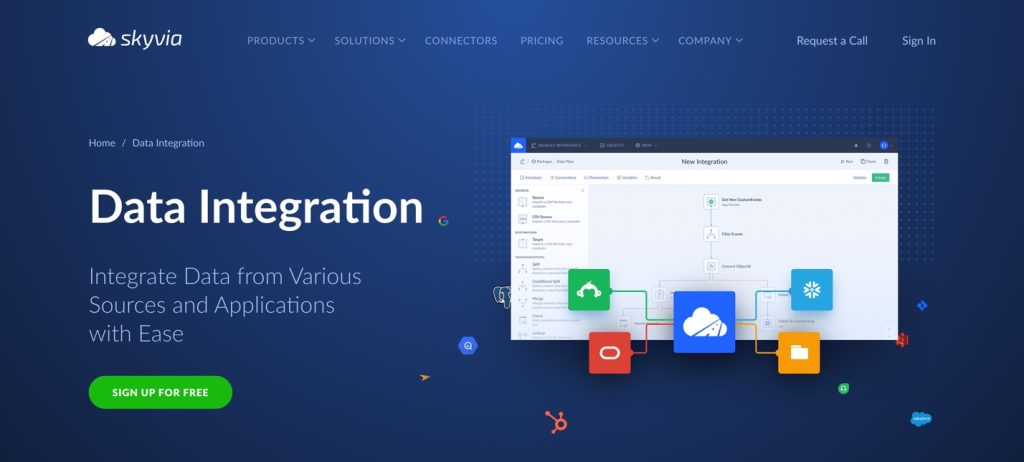
Skyvia is a powerful data integration platform that takes data management to the next level. It doesn’t just move data from one place to another; it ensures the process is smooth, reliable, and traceable. By connecting a wide range of sources and syncing them with your data lineage tool, Skyvia helps ensure your dataflows are always visible and organized.
Here’s how Skyvia integrates with other platforms to enhance overall data management:
- Seamless Connectivity. Skyvia offers pre-built connectors with 200+ databases, cloud platforms (like Salesforce, Google BigQuery, and Amazon Redshift), CRMs, marketing, and e-commerce platforms, etc., ensuring that your data lineage tool can track dataflows from start to finish, no matter how many systems are involved.
- Consistent Data Sync. Skyvia automates data synchronization between systems, ensuring you can get all changes and updates. This way, you get accurate, up-to-date information about data’s journey across systems.
- Easy Data Migration. Skyvia can also help extract and move data across SaaS applications, databases, or cloud services where native connectors are unavailable.
Additional Benefits Skyvia Brings to the Table
Skyvia doesn’t just stop at helping with data lineage. It offers a ton of extra features that make any data-related task even more straightforward.
- Simplified Data Integration: Its standout feature is the no-code interface, which makes integrating different systems a breeze. You don’t need a team of developers to get your systems talking — Skyvia’s user-friendly platform makes it easy to set up integrations and start syncing your data across platforms.
- Automation and Scheduling. The platform provides scheduling automatic data syncs so that information is always up-to-date.
- Data Transformation. Skyvia doesn’t just move data; it can transform it on the fly, ensuring that the data entering your systems is formatted correctly and ready for analysis. This is key for maintaining clean, organized files across multiple platforms, directly impacting the quality of the data lineage tracking.
Rating
Conclusion
Modern businesses need data lineage tools to track, visualize, and manage dataflows through various ecosystems. Such tools provide the visibility and control businesses need to ensure data compliance and improve quality and governance.
Choosing the best service may sometimes be a headache and depends on the company’s current:
- infrastructure,
- scalability needs,
- team requirements.
Whether you opt for open-source, commercial, standalone, or embedded tools, each type can offer unique benefits.
Data integration platforms like Skyvia help companies simplify integration, automate updates, and ensure seamless connections across platforms. It makes it easy for businesses to maximize the value of their data, unlocking it’s full potential.
FAQ
A data lineage tool helps businesses track the flow of data from its source to its final destination, showing how data transforms along the way. It’s crucial to understand data dependencies, ensure compliance with regulations like GDPR, and improve data accuracy and trustworthiness in analytics and reporting.
Data lineage in SQL refers to tracking and documenting the flow of data as it moves through SQL databases, queries, and transformations. It shows where data originates (its source), how it is processed or transformed (through SQL operations like joins, aggregations, or filters), and where it ends up (its destination, such as tables, reports, or analytics dashboards).
Look for tools with robust visualization capabilities, real-time tracking of data flows, integration with your existing tech stack (e.g., databases, ETL tools, and BI platforms), and strong compliance features for regulatory requirements. Automation and scalability are also crucial for growing businesses.
Industries that rely heavily on data, such as finance, healthcare, retail, and technology, benefit the most. These tools help in regulatory compliance (e.g., GDPR, HIPAA), auditing, ensuring data quality, and optimizing data-driven decision-making.
While large enterprises often use data lineage tools due to their complex data ecosystems, many tools cater to small and medium-sized businesses. Scalable solutions like open-source or SaaS-based tools allow businesses of any size to manage data lineage effectively.
